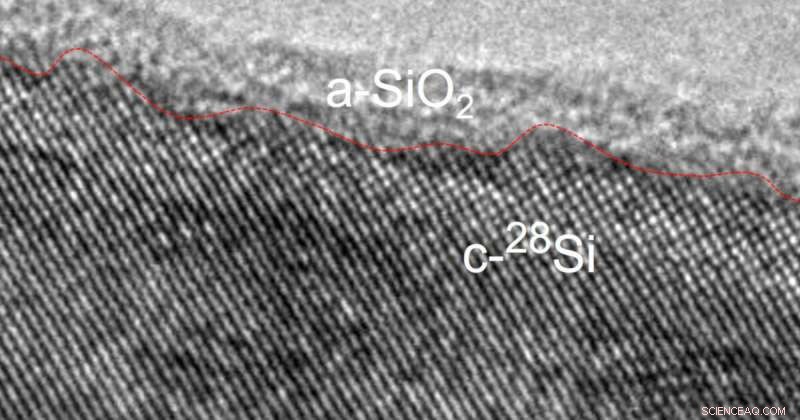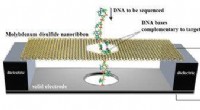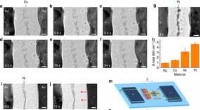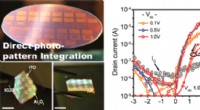Nye silicium nanotråde kan virkelig tage varmen

Transmissionselektronmikroskopbillede af silicium-28 nanotråd med et lag siliciumdioxid på overfladen. Kredit:Matthew R. Jones og Muhua Sun/Rice University
Forskere har demonstreret et nyt materiale, der leder varme 150 % mere effektivt end konventionelle materialer, der bruges i avancerede chipteknologier.
Enheden - en ultratynd silicium nanotråd - kunne muliggøre mindre, hurtigere mikroelektronik med en varmeoverførselseffektivitet, der overgår nuværende teknologier. Elektroniske enheder drevet af mikrochips, der effektivt spreder varme, ville til gengæld forbruge mindre energi – en forbedring, der kunne hjælpe med at mindske forbruget af energi produceret ved at brænde kulstofrige fossile brændstoffer, der har bidraget til den globale opvarmning.
"Ved at overvinde siliciums naturlige begrænsninger i dets evne til at lede varme tackler vores opdagelse en hindring inden for mikrochipteknologi," sagde Junqiao Wu, videnskabsmanden, der ledede Physical Review Letters undersøgelse, der rapporterer den nye enhed. Wu er en fakultetsforsker i Materials Sciences Division og professor i materialevidenskab og teknik ved UC Berkeley.
Varmens langsomme strømning gennem silicium
Vores elektronik er relativt overkommelig, fordi silicium - det foretrukne materiale til computerchips - er billigt og rigeligt. Men selvom silicium er en god leder af elektricitet, er det ikke en god varmeleder, når det reduceres til meget små størrelser - og når det kommer til hurtig databehandling, udgør det et stort problem for små mikrochips.
Inden i hver mikrochip findes der titusindvis af milliarder af siliciumtransistorer, der leder strømmen af elektroner ind og ud af hukommelsesceller, og koder databits som etaller og nuller, computerens binære sprog. Elektriske strømme løber mellem disse hårdtarbejdende transistorer, og disse strømme genererer uundgåeligt varme.
Varmen strømmer naturligt fra en varm genstand til en kølig genstand. Men varmestrømmen bliver vanskelig i silicium.
I sin naturlige form består silicium af tre forskellige isotoper - former af et kemisk grundstof, der indeholder lige mange protoner, men forskelligt antal neutroner (derfor forskellig masse) i deres kerner.
Omkring 92 % af silicium består af isotopen silicium-28, som har 14 protoner og 14 neutroner; omkring 5 % er silicium-29, der vejer 14 protoner og 15 neutroner; og kun 3% er silicium-30, en relativ sværvægter med 14 protoner og 16 neutroner, forklarede medforfatter Joel Ager, som har titler som seniorforsker i Berkeley Labs Materials Sciences Division og adjungeret professor i materialevidenskab og teknik ved UC Berkeley.
As phonons, the waves of atomic vibration that carry heat, wind their way through silicon's crystalline structure, their direction changes when they bump into silicon-29 or silicon-30, whose different atomic masses "confuse" the phonons, slowing them down.
"The phonons eventually get the idea and find their way to the cold end to cool the silicon material," but this indirect path allows waste heat to build up, which in turn slows your computer down, too, Ager said.
A big step toward faster, denser microelectronics
For many decades, researchers theorized that chips made of pure silicon-28 would overcome silicon's thermal conductivity limit, and therefore improve the processing speeds of smaller, denser microelectronics.
But purifying silicon down to a single isotope requires intense levels of energy which few facilities can supply—and even fewer specialize in manufacturing market-ready isotopes, Ager said.
Fortunately, an international project from the early 2000s enabled Ager and leading semiconductor materials expert Eugene Haller to procure silicon tetrafluoride gas—the starting material for isotopically purified silicon—from a former Soviet-era isotope manufacturing plant.
This led to a series of pioneering experiments, including a 2006 study published in Nature , whereby Ager and Haller fashioned silicon-28 into single crystals, which they used to demonstrate quantum memory storing information as quantum bits or qubits, units of data stored simultaneously as a one and a zero in an electron's spin.
Subsequently, semiconducting thin films and single crystals made with Ager's and Haller's silicon isotope material were shown to have a 10% higher thermal conductivity than natural silicon—an improvement, but from the computer industry's point of view, probably not enough to justify spending a thousand times more money to build a computer from isotopically pure silicon, Ager said.
But Ager knew that the silicon isotope materials were of scientific importance beyond quantum computing. So he kept what remained in a safe place at Berkeley Lab, just in case other scientists might need it, because few people have the resources to make or even purchase isotopically pure silicon, he reasoned.
A path toward cooler tech with silicon-28
About three years ago, Wu and his graduate student Penghong Ci were trying to come up with new ways to improve the heat transfer rate in silicon chips.
One strategy to make more efficient transistors involves using a type of nanowire called a Gate-All-Around Field Effect Transistor. In these devices, silicon nanowires are stacked to conduct electricity, and heat is generated simultaneously, Wu explained. "And if the heat generated is not extracted out quickly, the device would stop working, akin to a fire alarm blaring in a tall building without an evacuation map," he said.
But heat transport is even worse in silicon nanowires, because their rough surfaces—scars from chemical processing—scatter or "confuse" the phonons even more, he explained.
"And then one day we wondered, 'What would happen if we made a nanowire from isotopically pure silicon-28?'" Wu said.
Silicon isotopes are not something one can easily buy on the open market, and word had it that Ager still had some silicon isotope crystals in storage at Berkeley Lab—not a lot, but still enough to share "if someone has a great idea about how to use it," Ager said. "And Junqiao's new study was such a case."
A surprising big reveal with nano tests
"We're really fortunate that Joel happened to have the isotopically enriched silicon material ready to use for the study," Wu said.
Using Ager's silicon isotope materials, the Wu team tested the thermal conductivity in bulk 1-millimeter-size silicon-28 crystals versus natural silicon—and again, their experiment confirmed what Ager and his collaborators discovered years ago—that bulk silicon-28 conducts heat only 10% better than natural silicon.
Now for the nano test. Using a technique called electroless etching, Ci made natural silicon and silicon-28 nanowires just 90 nanometers (billionths of a meter) in diameter—about a thousand times thinner than a single strand of human hair.
To measure the thermal conductivity, Ci suspended each nanowire between two microheater pads outfitted with platinum electrodes and thermometers, and then applied an electrical current to the electrode to generate heat on one pad that flows to the other pad via the nanowire.
"We expected to see only an incremental benefit—something like 20%—of using isotopically pure material for nanowire heat conduction," Wu said.
But Ci's measurements astonished them all. The Si-28 nanowires conducted heat not 10% or even 20%, but 150% better than natural silicon nanowires with the same diameter and surface roughness.
This defied everything that they had expected to see, Wu said. A nanowire's rough surface typically slows phonons down. So what was going on?
High-resolution TEM (transmission electron microscopy) images of the material captured by Matthew R. Jones and Muhua Sun at Rice University uncovered the first clue:a glass-like layer of silicon dioxide on the silicon-28 nanowire surface.
Computational simulation experiments at the University of Massachusetts Amherst led by Zlatan Aksamija, a leading expert on the thermal conductivity of nanowires, revealed that the absence of isotope "defects"—silicon-29 and silicon-30—prevented phonons from escaping to the surface, where the silicon dioxide layer would drastically slow down the phonons. This in turn kept phonons on track along the direction of heat flow—and therefore less "confused"—inside the silicon-28 nanowire's "core." (Aksamija is currently an associate professor of materials science and engineering at the University of Utah.)
"This was really unexpected. To discover that two separate phonon-blocking mechanisms—the surface versus the isotopes, which were previously believed to be independent of each other—now work synergistically to our benefit in heat conduction is very surprising but also very gratifying," Wu said.
"Junqiao and the team discovered a new physical phenomenon," Ager said. "This is a real triumph for curiosity-driven science. It's quite exciting."
Wu said that the team next plans to take their discovery to the next step:by investigating how to "control, rather than merely measure, heat conduction in these materials." + Udforsk yderligere
Thermoelectric silicon material reaches record-low thermal conductivity
 Varme artikler
Varme artikler
-
 Team foreslår elektronisk bevægelsessensor i nanoskala som DNA-sequencerNISTs foreslåede design til en DNA-sequencer baseret på en elektronisk bevægelsessensor. Et nanoskalabånd af molybdændisulfid suspenderes over en metalelektrode og nedsænkes i vand. Enkeltstrenget DNA
Team foreslår elektronisk bevægelsessensor i nanoskala som DNA-sequencerNISTs foreslåede design til en DNA-sequencer baseret på en elektronisk bevægelsessensor. Et nanoskalabånd af molybdændisulfid suspenderes over en metalelektrode og nedsænkes i vand. Enkeltstrenget DNA -
 Metalpartikler i faste stoffer er ikke så faste som de ser ud, memristor undersøgelse viserUniversal dynamisk adfærd observeret med forskellige metal nanokluster. Kredit: Naturkommunikation I arbejde, der afslører noget af magien bag memristors og resistiv random access memory, eller R
Metalpartikler i faste stoffer er ikke så faste som de ser ud, memristor undersøgelse viserUniversal dynamisk adfærd observeret med forskellige metal nanokluster. Kredit: Naturkommunikation I arbejde, der afslører noget af magien bag memristors og resistiv random access memory, eller R -
 grønnere, billige transistorer varsler fremskridt inden for fleksibel elektronikSom teknologivirksomheden LG demonstrerede i sommer med afsløringen af sin 18-tommer fleksible skærm, den næste generation af roll-up-skærme er fristende tæt på. Forskere rapporterer nu i tidsskrift
grønnere, billige transistorer varsler fremskridt inden for fleksibel elektronikSom teknologivirksomheden LG demonstrerede i sommer med afsløringen af sin 18-tommer fleksible skærm, den næste generation af roll-up-skærme er fristende tæt på. Forskere rapporterer nu i tidsskrift -
 Lægemiddelleveringsmikrokapsler mærket med zirconium-89 kan spores ved PET-billeddannelseKredit:CC0 Public Domain University of Alabama i Birmingham polymer- og radionuklidkemikere rapporterer, hvad de siger, kan repræsentere et stort skridt fremad i mikrokapsel-lægemiddelleveringssys
Lægemiddelleveringsmikrokapsler mærket med zirconium-89 kan spores ved PET-billeddannelseKredit:CC0 Public Domain University of Alabama i Birmingham polymer- og radionuklidkemikere rapporterer, hvad de siger, kan repræsentere et stort skridt fremad i mikrokapsel-lægemiddelleveringssys
- Hvordan man laver et tårn ud af et stykke papir
- Efterfølgeren til COMPASS-eksperimentet vil måle grundlæggende egenskaber for protonen og dens sl…
- Kan vi opdage vand på eksoplaneter?
- Er crowd-control våben farlige? Meget, siger ekspert
- Lille bitte, biokompatibel laser kunne fungere inde i levende væv
- Levanluhta smykker forbinder Finland med et europæisk udvekslingsnetværk


